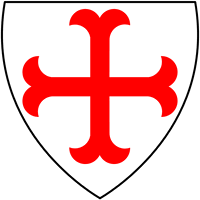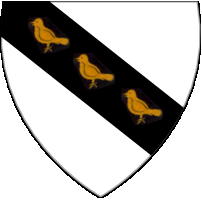>> | Home | Books | Visit | Explore & More | Events | FAQs | Contacts
Hemyock Castle
Ancient Heart of the Blackdowns
Notable Owners
Over the centuries, several notable people have owned or been linked with Hemyock Castle.
- Domesday Book
- Robert Foliot
- Richard de Hydon and Margaret Hydon
- Sir Joyce Dynham
- Sir Gilbert Knoville
- Sir Peter de Uvedale
- Sir William and Lady Margaret Asthorpe
- Sir Thomas Pomeroy of Combe Raleigh, Devon
- Carew, Bourchier, Zouche and Arundell
- Lord Chief Justice Sir John Popham
- Every, Leigh
- General John Graves and Elizabeth Posthuma Simcoe
- Peter Orlando Hutchinson
- Bartons
- Lords
- Captain & Mrs W W Sheppard
Domesday Book
Hemyock Manor is listed in the 1086 Domesday Book as Hamihoc, held by King William, granted to Baldwin. In 1086, it appears to have been occupied by William Cheever. The church went to Torre Abbey and the manor to the Honor of Plympton.
For more information see: Hemyock in the Domesday Book
Foliot
Hemyock Manor was granted to Robert Foliot by Richard de Redvers, Earl of Devon.
1195: Hemyock was in the King's hands as the result of an escheat.
1198: Robert Foliot's lands were in the joint possession of Geoffrey de Barenton, Thomas Foliot, Richard de Hidon and Emma de Botreaux, his grandchildren.
Hydons (or Hydens or Hidons) of Clayhidon

Hydon Shield
Between 1212 and 1228, Richard de Hydon became the sole lord of the manor of Hemyock. In 1238 he held it of the honor of Plympton. He gave 30 acres of his land at Bowerhayes, to the new Cistercian abbey at Dunkeswell. (Founded in 1201 by Lord William Brewer, former Sheriff of Devon.)
After Richard de Hydon's death (between 1241 & 1255) Hemyock Manor passed to his son Sir John de Hydon of Hemeock, until his death in 1272. His son Sir Richard de Hydon inherited Hemyock Manor.
Note. The rare Henry III gold penny dating from about 1257 found in a Hemyock field in 2021, probably belonged to Sir John de Hydon.
In the late 13th Century, Margaret Hydon inherited the Manors of Hemyock and Clayhidon from her father Sir Richard de Hydon, and the Manors of Morleigh and Storridge from her mother Isabel (née Fisacre). For further details see:
Dynhams (or Dinhams) of Dinan, Hartland & Nutwell

Dynham Shield
Margaret Hydon (1272 – 1357) married three times. In 1292, she married Sir Joyce (or Josce or John) de Dynham (˜1274 – 1300/1) of Hartland and Nutwell, the eldest son of Sir Oliver Dynham of Hartland, another Norman family, originally from Dinan in Brittany. They had two sons, John and Oliver. Margaret was widowed in 1300/1.
In 1309 she married Sir Gilbert Knoville (˜1265 – 1313/4), a widower of Honyngton (ie. Honiton) Devon, who was Sheriff of Devon. He already had one son John, whose properties Margaret later held in trust. They had no children.
Margaret's elder son, John Dinham, came of age in 1316. Her younger son Oliver inherited her properties, including Hemyock. Apart from brief periods, the Dinham family held Hemyock until the death of the last member, Sir John Dinham, in 1501/2. Sir John had been Sheriff of Devon, Lord High Treasurer of England, and lifelong loyal supporter of King Edward IV. For further details see:
Sir Peter de Uvedale (1296 – 1336)

Uvedale Shield
In 1324, Margaret Hydon married her third husband, Sir Peter de Uvedale, a much younger man, born in 1296. They probably made Hemyock their home. They funded and endowed a perpetual Chantry in Hemyock Parish Church dedicated to the Blessed Virgin Saint Katherine; for the well-being and repose of their souls, and those of Margaret's parents.
Sir Peter died in 1336. Lady Margaret lived on until 1357. They are both buried under the floor of their Chantry Chapel, now incorporated into St. Mary's Church, Hemyock.
By an interesting coincidence, a descendent of the Uvedales later had dealings with General Simcoe who was then Lt. Governor of Upper Canada ....and also owner of Hemyock Castle:
In 1787, Mathew Udell from Ellastone, Staffordshire, was sent to Canada with the 26th or Cameronian Regiment. He later petitioned for a grant of land in Quebec but was refused in 1802. His son John Udell who had also served with the 26th Regiment had more luck: He successfully applied to General Simcoe for a grant of land. In 1795, he was granted land in Beverley Township, in the Niagara peninsula of Upper Canada.
With thanks to Walter Udell, a descendent of Mathew Udell, who has researched the Uvedale, Udall and Udell families. See: Walter Udell's family & castle webpages
Sir William and Lady Margaret Asthorpe
(or Asthorp, or Hasthorp, etc)

Asthorpe Shield
In 1362 Sir William Asthorpe married the heiress Lady Margaret Dynham, then aged 15. Her brother, two sisters and father had all died, possibly from the Black Death, leaving Margaret to inherit the family's manors.
Margaret had inherited Hemyock and Clayhidon from the Hydons; Morleigh and Storridge from the Fisacres; Sampford Peverell, Aller Peverell and estates in Somerset from her grandmother Edith Cotel. These lands had been in the custody of her grandfather Sir Guy de Brien.
For further details see:
On 5th November 1380, King Richard II granted Sir William and Lady Margaret Asthorpe (née Dynham) a licence to crenellate their fortified manor house at Hemyock. Records include:
Entry in the Patent Rolls: 4 Richard II, Membrane 11, Nov 5th 1380, Northampton.
Summary: Licence for William Asthorp, knight, and Margaret his wife, to crenellate the dwelling house of their manor of Hemyok with a wall of stone and lime. By p.s.
On the same day, King Richard II also granted Sir William and Lady Margaret "free warren," ie. hunting rights, over all of their manors:
Entry in the Charter Rolls: 4 Richard II, Membrane 6, Nov 5th 1380, Northampton.
Summary: Grant, of special grace, to William Asthorpe, knight, and Margaret his wife, and their heirs, of free warren in all their demesne lands of Hemyok, Hidon, Sandford Peverel, Alre Peverel and Morlegh, co. Devon, and Camlerton, co. Somerset.
Sir William Asthorpe died in 1399, shortly after Lady Margaret, his wife. Because he was "illegitimate" and died without an heir, Sir William's estates including Hemyock Castle were taken into the King's hands before eventually reverting to his wife's family, the Dynhams. For further details see:
Note: Richard II had become king in 1377, when he was only ten years old. His reign included "The Peasants' Revolt in 1381," the continuation of The Hundred Years War with France, and many other crises. Sir William was probably regarded as a reliable, loyal supporter: a "king's man." Presumably, this explains why Sir William was permitted to marry the heiress Lady Margaret Dynham, and later why they were granted the licence to crenellate their Hemyock manor house. It is likely that Sir William was tasked with countering the power of the powerful local land-owners, who opposed and later helped to depose King Richard II. King Richard II was deposed and then murdered in 1399. This helps to explain the many conflicts and accusations involving Sir William.
Sir Thomas Pomeroy of Combe Raleigh, Devon
In 1400, the new King Henry IV granted Hemyock to Sir Thomas Pomeroy, for life: In March 1400, Henry IV made Sir Thomas Pomeroy the King's esquire, and by December of that year, The King's Knight. (Powley, page 64..says Henry IV had knighted him at his last voyage to Scotland.) He was given a grant for life of William Hasthorpe's land in Hemyock. Thomas de la Pomerai gave good service in Scotland and Wales between 1400 and 1402. (See Edward Powley – Annuls of the Pomeroy Family.)
King Henry IV died on 20th March 1413. He was succeeded by his son King Henry V (reigned 21 March 1413 – 31 August 1422), who was succeeded by his son King Henry VI (reigned 1 September 1422 – 4 March 1461).
Sir Thomas's wife Joan (daughter of Sir James Chudleigh of Ashton and Shirwell, Devon) died on 14th December 1422. In 1422, he married Joan, widow of Sir John Whalesborough of Whalesborough, Cornwall, daughter of Sir John Raleigh of Nettlecombe, Somerset. In March 1423, Sir Thomas and his new wife went on Pilgrimage to Rome in celebration of the 1423 Jubilee.
Sir Thomas died on the feast of St. Laurence (10 Aug or possibly 3 Feb) 1426. Hemyock reverted to the Dynhams until the death of Sir John Dynhan in 1501.
Carew, Bourchier, Zouche and Arundell
After the death of Sir John Dinham on 28th January 1501, Hemyock was divided between his four surviving sisters, his co-heiresses:
- Margory, who married Nicholas IV Carew (1424 – 1470) of Mohuns Ottery, Luppitt, Devon.
Their son Vice-Admiral Sir George Carew died without heirs in 1545 when the Mary Rose sank.
Their son Peter Carew (1514? – 27 November 1575) died without heirs. - Elizabeth, widow of Fouke / Fulk Bourchier (Lord Fitzwarin) (died in 1479), a distant cousin from the Fouke branch of the Dinan family.
Their son John Bouchier became the first Earl of Bath. - Joan, who married Lord John la Zouche, 7th Baron Zouche, 8th Baron St Maur (died 23 June 1526).
- Katherine (1453 – 25 September1501?), who married Sir Thomas Arundell of Lanherne, Cornwall (1454 – 1485). Her share passed to their first son Sir John Arundell (1474 – 1545).
The Arundells also owned Wardour Castle near Shaftesbury, Wiltshire.
Further information is displayed at the Castle, in the Hemyock Castle Guidebook, and in the booklet "Hemyock Castle – The Continuing Story."
Home | Books | Visit | Explore & More | Events | FAQs | Contacts
Hemyock Castle, Hemyock, CULLOMPTON, Devon, EX15 3RJ, UK.
© 2001–2024. Prepared and published by Curlew Communications Ltd

